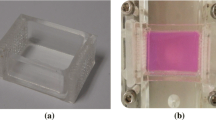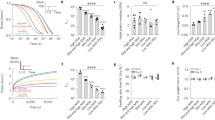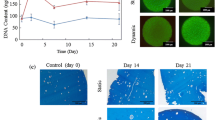Abstract
It remains unclear how specific mechanical signals generated by applied dynamic compression (DC) regulate chondrocyte biosynthetic activity. It has previously been suggested that DC-induced interstitial fluid flow positively impacts cartilage-specific matrix production. Modifying fluid flow within dynamically compressed hydrogels therefore represents a promising approach to controlling chondrocyte behavior, which could potentially be achieved by changing the construct architecture. The objective of this study was to first determine the influence of construct architecture on the mechanical environment within dynamically compressed agarose hydrogels using finite element (FE) modeling and to then investigate how chondrocytes would respond to this altered environment. To modify construct architecture, an array of channels was introduced into the hydrogels. Increased magnitudes of fluid flow were predicted in the periphery of dynamically compressed solid hydrogels and also around the channels in the dynamically compressed channeled hydrogels. DC was found to significantly increase sGAG synthesis in solid constructs, which could be attributed at least in part to an increase in DNA. DC was also found to preferentially increase collagen accumulation in regions of solid and channeled constructs where FE modeling predicted higher levels of fluid flow, suggesting that this stimulus is important for promoting collagen production by chondrocytes embedded in agarose gels. In conclusion, this study demonstrates how the architecture of cell-seeded scaffolds or hydrogels can be modified to alter the spatial levels of biophysical cues throughout the construct, leading to greater collagen accumulation throughout the engineered tissue rather than preferentially in the construct periphery. This system also provides a novel approach to investigate how chondrocytes respond to altered levels of biophysical stimulation.
Similar content being viewed by others
Abbreviations
- DC:
-
Dynamic compression
- FE:
-
Finite element
- sGAG:
-
Sulfated glycosaminoglycan
- ECM:
-
Extracellular matrix
- PBS:
-
Phosphate-buffered saline
- hgDMEM:
-
High-glucose Dulbecco’s modified Eagle’s medium
- FBS:
-
Fetal bovine serum
- DMSO:
-
Dimethyl sulphoxide
- P1:
-
Passage one
- FGF-2:
-
Fibroblast growth factor-2
- CDM:
-
Chondrogenic medium
- PTFE:
-
Polytetrafluoroethylene
- PDMS:
-
Polydimethylsiloxane
- CNC:
-
Computer numerical controlled
- TGF-β 3:
-
Transforming growth factor-beta 3
- FS:
-
Free swelling
- DCS:
-
Dynamically compressed solid
- DCM:
-
Dynamically compressed microchannel
- FSM:
-
Free swelling microchannel
- FSS:
-
Free swelling solid
References
Albro MB, Li R, Banerjee RE, Hung CT, Ateshian GA (2010) Validation of theoretical framework explaining active solute uptake in dynamically loaded porous media. J Biomech 43(12): 2267–2273
Appelman TP, Mizrahi J, Elisseeff JH, Seliktar D (2009) The differential effect of scaffold composition and architecture on chondrocyte response to mechanical stimulation. Biomaterials 30(4): 518–525
Appelman TP, Mizrahi J, Elisseeff JH, Seliktar D (2011) The influence of biological motifs and dynamic mechanical stimulation in hydrogel scaffold systems on the phenotype of chondrocytes. Biomaterials 32(6): 1508–1516
Benya PD, Shaffer JD (1982) Dedifferentiated chondrocytes reexpress the differentiated collagen phenotype when cultured in agarose gels. Cell 30(1): 215–224
Bian L, Angione SL, Ng KW, Lima EG, Williams DY, Mao DQ, Ateshian GA, Hung CT (2009) Influence of decreasing nutrient path length on the development of engineered cartilage. Osteoarthr Cartil 17(5): 677–685
Bryant SJ, Chowdhury TT, Lee DA, Bader DL, Anseth KS (2004) Crosslinking density influences chondrocyte metabolism in dynamically loaded photocrosslinked poly(ethylene glycol) hydrogels. Ann Biomed Eng 32(3): 407–417
Bryant SJ, Nicodemus GD, Villanueva I (2008) Designing 3D photopolymer hydrogels to regulate biomechanical cues and tissue growth for cartilage tissue engineering. Pharm Res 25(10): 2379–2386
Buckley CT, Thorpe SD, Kelly DJ (2009a) Engineering of large cartilaginous tissues through the use of microchanneled hydrogels and rotational culture. Tissue Eng Part A 15(11): 3213–3220
Buckley CT, Thorpe SD, O’Brien FJ, Robinson AJ, Kelly DJ (2009b) The effect of concentration, thermal history and cell seeding density on the initial mechanical properties of agarose hydrogels. J Mech Behav Biomed Mater 2(5): 512–521
Buschmann MD, Gluzband YA, Grodzinsky AJ, Kimura JH, Hunziker EB (1992) Chondrocytes in agarose culture synthesize a mechanically functional extracellular matrix. J Orthop Res 10(6): 745–758. doi:10.1002/jor.1100100602
Buschmann MD, Gluzband YA, Grodzinsky AJ, Hunziker EB (1995) Mechanical compression modulates matrix biosynthesis in chondrocyte/agarose culture. J Cell Sci 108(Pt 4): 1497–1508
Buschmann MD, Kim YJ, Wong M, Frank E, Hunziker EB, Grodzinsky AJ (1999) Stimulation of aggrecan synthesis in cartilage explants by cyclic loading is localized to regions of high interstitial fluid flow. Arch Biochem Biophys 366(1): 1–7
Chowdhury TT, Bader DL, Lee DA (2001) Dynamic compression inhibits the synthesis of nitric oxide and PGE2 by IL-1β-stimulated chondrocytes cultured in agarose constructs. Biochem Biophys Res Commun 285(5): 1168–1174
Cowin SC (2002) Mechanosensation and fluid transport in living bone. J Musculoskelet Neuronal Interact 2(3): 256–260
Cowin SC (2007) The significance of bone microstructure in mechanotransduction. J Biomech 40(Suppl. 1): S105–S109
Gemmiti CV, Guldberg RE (2006) Fluid flow increases type II collagen deposition and tensile mechanical properties in bioreactor-grown tissue-engineered cartilage. Tissue Eng 12(3): 469–479
Gu WY, Yao H, Huang CY, Cheung HS (2003) New insight into deformation-dependent hydraulic permeability of gels and cartilage, and dynamic behavior of agarose gels in confined compression. J Biomech 36(4): 593–598
Grodzinsky AJ, Levenston ME, Jin M, Frank EH (2000) Cartilage tissue remodeling in response to mechanical forces. Annu Rev Biomed Eng 2: 691–713. doi:10.1146/annurev.bioeng.2.1.691
Hunter C, Mouw JK, Levenston ME (2004) Dynamic compression of chondrocyte-seeded fibrin gels: effects on matrix accumulation and mechanical stiffness. Osteoarthr Cartil 12(2): 117–130
Ignat’eva NY, Danilov NA, Averkiev SV, Obrezkova MV, Lunin VV, Sobol EN (2007) Determination of hydroxyproline in tissues and the evaluation of the collagen content of the tissues. J Ann Chem 62(1): 51–57
Kafienah W, Sims TJ (2004) Biochemical methods for the analysis of tissue-engineered cartilage. Methods Mol Biol 238: 217–230
Kelly DJ, Prendergast PJ (2005) Mechano-regulation of stem cell differentiation and tissue regeneration in osteochondral defects. J Biomech 38(7): 1413–1422
Kelly T-AN, Wang CCB, Mauck RL, Ateshian GA, Hung CT (2004) Role of cell-associated matrix in the development of free-swelling and dynamically loaded chondrocyte-seeded agarose gels. Biorheology 41(3–4): 223–237
Kelly T-AN, Ng KW, Ateshian GA, Hung CT (2009) Analysis of radial variations in material properties and matrix composition of chondrocyte-seeded agarose hydrogel constructs. Osteoarthr Cartil 17(1): 73–82
Kim YJ, Sah RL, Doong JY, Grodzinsky AJ (1988) Fluorometric assay of DNA in cartilage explants using Hoechst 33258. Anal Biochem 174(1): 168–176
Kim YJ, Sah RLY, Grodzinsky AJ, Plaas AHK, Sandy JD (1994) Mechanical regulation of cartilage biosynthetic behavior: physical stimuli. Arch Biochem Biophys 311(1): 1–12
Lee DA, Bader DL (1997) Compressive strains at physiological frequencies influence the metabolism of chondrocytes seeded in agarose. J Orthop Res 15(2): 181–188
Lee DA, Frean SP, Lees P, Bader DL (1998) Dynamic mechanical compression influences nitric oxide production by articular chondrocytes seeded in agarose. Biochem Biophys Res Commun 251(2): 580–585
Lee DA, Noguchi T, Frean SP, Lees P, Bader DL (2000) The influence of mechanical loading on isolated chondrocytes seeded in agarose constructs. Biorheology 37(1–2): 149–161
MSC (2008) Marc 2008r1–volume A: theory and user information. MSC.Software Corporation, 2 MacArthur Place, Santa Ana, CA 92707, USA. http://www.mscsoftware.com
Martin I, Obradovic B, Treppo S, Grodzinsky AJ, Langer R, Freed LE, Vunjak-Novakovic G (2000) Modulation of the mechanical properties of tissue engineered cartilage. Biorheology 37(1–2): 141–147
Mauck RL, Soltz MA, Wang CC, Wong DD, Chao PH, Valhmu WB, Hung CT, Ateshian GA (2000) Functional tissue engineering of articular cartilage through dynamic loading of chondrocyte-seeded agarose gels. J Biomech Eng 122(3): 252–260
Mauck RL, Seyhan SL, Ateshian GA, Hung CT (2002) Influence of seeding density and dynamic deformational loading on the developing structure/function relationships of chondrocyte-seeded agarose hydrogels. Ann Biomed Eng 30(8): 1046–1056
Mauck RL, Hung CT, Ateshian GA (2003a) Modeling of neutral solute transport in a dynamically loaded porous permeable gel: implications for articular cartilage biosynthesis and tissue engineering. J Biomech Eng 125(5): 602–614
Mauck RL, Nicoll SB, Seyhan SL, Ateshian GA, Hung CT (2003b) Synergistic action of growth factors and dynamic loading for articular cartilage tissue engineering. Tissue Eng 9(4): 597–611. doi:10.1089/107632703768247304
Mauck RL, Byers BA, Yuan X, Tuan RS (2007) Regulation of cartilaginous ECM gene transcription by chondrocytes and MSCs in 3D culture in response to dynamic loading. Biomech Model Mechanobiol 6(1–2): 113–125
Ng KW, Mauck RL, Statman LY, Lin EY, Ateshian GA, Hung CT (2006) Dynamic deformational loading results in selective application of mechanical stimulation in a layered, tissue-engineered cartilage construct. Biorheology 43(3–4): 497–507
Prendergast PJ, Huiskes R, Søballe K (1997) Biophysical stimuli on cells during tissue differentiation at implant interfaces. J Biomech 30(6): 539–548
Sheehy EJ, Buckley CT, Kelly DJ (2011) Chondrocytes and bone marrow-derived mesenchymal stem cells undergoing chondrogenesis in agarose hydrogels of solid and channelled architectures respond differentially to dynamic culture conditions. J Tissue Eng Regen Med 5(9): 747–758
Silva MMCG, Cyster LA, Barry JJA, Yang XB, Oreffo ROC, Grant DM, Scotchford CA, Howdle SM, Shakesheff KM, Rose FRAJ (2006) The effect of anisotropic architecture on cell and tissue infiltration into tissue engineering scaffolds. Biomaterials 27(35): 5909–5917
Sun D, Aydelotte MB, Maldonado B (1986) Clonal analysis of the population of chondrocytes from the Swarm rat chondrosarcoma in agarose culture. J Orthop Res 4(4): 427–436
Thorpe SD, Buckley CT, Vinardell T, O’Brien FJ, Campbell VA, Kelly DJ (2010) The response of bone marrow-derived mesenchymal stem cells to dynamic compression following tgf-β3 induced chondrogenic differentiation. Ann Biomed Eng 38(9):2896–2909
Villanueva I, Hauschulz DS, Mejic D, Bryant SJ (2008) Static and dynamic compressive strains influence nitric oxide production and chondrocyte bioactivity when encapsulated in PEG hydrogels of different crosslinking densities. Osteoarthr Cartil 16(8): 909–918
Villanueva I, Gladem SK, Kessler J, Bryant SJ (2010) Dynamic loading stimulates chondrocyte biosynthesis when encapsulated in charged hydrogels prepared from poly(ethylene glycol) and chondroitin sulfate. Matrix Biol 29(1): 51–62
Waldman SD, Couto DC, Grynpas MD, Pilliar RM, Kandel RA (2006) A single application of cyclic loading can accelerate matrix deposition and enhance the properties of tissue-engineered cartilage. Osteoarthr Cartil 14(4): 323–330
Wang QG, Magnay JL, Nguyen B, Thomas CR, Zhang Z, El Haj AJ, Kuiper NJ (2009) Gene expression profiles of dynamically compressed single chondrocytes and chondrons. Biochem Biophys Res Commun 379(3): 738–742
Author information
Authors and Affiliations
Corresponding author
Electronic Supplementary Material
The Below is the Electronic Supplementary Material.
Rights and permissions
About this article
Cite this article
Mesallati, T., Buckley, C.T., Nagel, T. et al. Scaffold architecture determines chondrocyte response to externally applied dynamic compression. Biomech Model Mechanobiol 12, 889–899 (2013). https://doi.org/10.1007/s10237-012-0451-2
Received:
Accepted:
Published:
Issue Date:
DOI: https://doi.org/10.1007/s10237-012-0451-2




